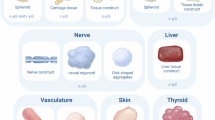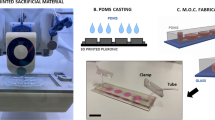Abstract
An in vitro 3D model was developed utilizing a synthetic microgravity environment to facilitate studying the cell interactions. 2D monolayer cell culture models have been successfully used to understand various cellular reactions that occur in vivo. There are some limitations to the 2D model that are apparent when compared to cells grown in a 3D matrix. For example, some proteins that are not expressed in a 2D model are found up-regulated in the 3D matrix. In this paper, we discuss techniques used to develop the first known large, free-floating 3D tissue model used to establish tumor spheroids. The bioreactor system known as the High Aspect Ratio Vessel (HARVs) was used to provide a microgravity environment. The HARVs promoted aggregation of keratinocytes (HaCaT) that formed a construct that served as scaffolding for the growth of mouse melanoma. Although there is an emphasis on building a 3D model with the proper extracellular matrix and stroma, we were able to develop a model that excluded the use of matrigel. Immunohistochemistry and apoptosis assays provided evidence that this 3D model supports B16.F10 cell growth, proliferation, and synthesis of extracellular matrix. Immunofluorescence showed that melanoma cells interact with one another displaying observable cellular morphological changes. The goal of engineering a 3D tissue model is to collect new information about cancer development and develop new potential treatment regimens that can be translated to in vivo models while reducing the use of laboratory animals.







Similar content being viewed by others
References
Becker J. L.; Blanchard D. K. Characterization of primary breast carcinomas grown in three-dimensional cultures. J. Surg. Res. 1422: 256–262; 2007. doi:10.1016/j.jss.2007.03.016.
Christofori G.; Semb H. The role of the cell-adhesion molecule E-cadherin as a tumor-suppressor gene. Trends Biochem. Sci. 242: 73–76; 1999. doi:10.1016/S0968-0004(98)01343-7.
Coolen N. A.; Verkerk M.; Reijnen L.; Vlig M.; Van den Bogaerdt A. J.; Breetveld M.; Gibbs S.; Middelkoop E.; Ulrich M. M. Culture of keratinocytes for transplantation without the need of feeder layer cells. Cell Transplant 166: 649–661; 2007.
Doolin E. J.; Geldziler B.; Strande L.; Kain M.; Hewitt C. Effects of microgravity on growing cultured skin constructs. Tissue Eng. 56: 573–582; 1999. doi:10.1089/ten.1999.5.573.
Fang D.; Herlyn M. The dynamic roles of cell-surface receptors in melanoma development. Humana Press Inc, Totowa NJ2006.
Fischbach C.; Chen R.; Matsumoto T.; Schmelzle T.; Brugge J. S.; Polverini P. J.; Mooney D. J. Engineering tumor with 3D scaffolds. Nature Methods 410: 855–860; 2007. doi:10.1038/nmeth1085.
Freed L. E.; Vunjak-Novakovic G. Microgravity tissue engineering. In vitro Cell. Dev. Biol. Anim. 33: 381–385; 1997. doi:10.1007/s11626-997-0009-2.
Gao H.; Ayyaswamy P. S.; Ducheyne P. Dynamics of a microcarrier particle in the simulated microgravity environment of a rotating-wall vessel. Microgravity Sci. Technol. 93: 154–165; 1997.
Ghosh S.; Maity P. Augmented antitumor effects of combination therapy with VEGF antibody and cisplatin on murine B16F10 melanoma cells. Int. Immunopharmacol. 713: 1598–608; 2007. doi:10.1016/j.intimp.2007.08.017.
Goodwin T. J.; Prewett T. L.; Spaulding G. F.; Becker J. L. Three-dimensional culture of a mixed mullerian tumor of the ovary: expression of in vivo characteristics. In Vitro Cell Dev. Biol. Anim. 335: 366–374; 1997. doi:10.1007/s11626-997-0007-4.
Goodwin T. J.; Prewett T. L.; Wolf D. A.; Spaulding G. F. Reduced shear stress: a major component in the ability of mammalian tissues to form three-dimensional assemblies in simulated microgravity. J. Cell Biochem. 513: 301–311; 1993. doi:10.1002/jcb.240510309.
Griffith L. G.; Swartz M. A. Capturing complex 3D tissue physiology in vitro. Nat. Rev. Mol. Cell Biol. 7: 211–224; 2006. doi:10.1038/nrm1858.
Hammond T. G.; Hammond J. M. Optimized suspension culture: the rotating-wall vessel. Am. J. Physiol. Renal. Physiol. 281: F12–F25; 2001.
Hindie M.; Vayssade M.; Dufresne M.; Queant S.; Warocquier-Clerout R.; Legeay G.; Vigneron P.; Oliver V.; Duval J.-L.; Nagel M.-D. Interactions of B16F10 melanoma cells aggregated on a cellulose substrate. J. Cell. Biochem. 99: 96–104; 2006. doi:10.1002/jcb.20833.
Hsu M. Y.; Meier F. E.; Herlyn M. Melanoma development and progression: a conspiracy between tumor and host. Differentiation 70: 522–536; 2002. doi:10.1046/j.1432-0436.2002.700906.x.
Hsu M. Y.; Meier F. E.; Nesbit M.; Hsu J. Y.; Van Belle P.; Elder D. E.; Herlyn M. E-cadherin expression in melanoma cells restores keratinocyte-mediated growth control and down-regulates expression of invasion-related adhesion receptors. Am. J. Pathol. 1565: 1515–1525; 2000.
Ingram M.; Techy G. B.; Saroufeem R.; Yazan O.; Narayan K. S.; Goodwin T. J.; Spaulding G. F. Three-dimensional growth patterns of various human tumor cell lines in simulated microgravity of a NASA bioreactor. In Vitro Cell Dev. Biol. Anim. 336: 459–466; 1997. doi:10.1007/s11626-997-0064-8.
Jong B. K.; Robert S.; O’Hare M. J. Three-dimensional in vitro tissue culture models of breast cancer — a review. Breast Cancer Res. Treat. 85: 281–291; 2004. doi:10.1023/B:BREA.0000025418.88785.2b.
Li G.; Herlyn M. Dynamics of intracellular communication during melanoma development. Mol. Med. Today 6: 163–169; 2000. doi:10.1016/S1357-4310(00)01692-0.
Li G.; Satyamoorthy K.; Herlyn M. Dynamics of cell interactions and communications during melanoma development. Crit. Rev. Oral Bio. Med. 131: 62–70; 2002. doi:10.1177/154411130201300107.
Licato L. L.; Prieto V. G.; Grimm E. A. A novel preclinical model of human malignant melanoma utilizing bioreactor rotating wall-vessels. In vitro Cell Dev. Biol. Anim. 37: 121–126; 2001. doi:10.1290/1071-2690(2001)037<0121:ANPMOH>2.0.CO;2.
Mengus-Feder C.; Ghosh S.; Reschner A.; Martin I.; Spagnoli G. C. New dimensions in tumor immunology: what does 3D culture reveal? Trends Mol. Med. 148: 333–340; 2008. doi:10.1016/j.molmed.2008.06.001.
Nakamura K.; Kuga H.; Morisaki T.; Baba E.; Sato N.; Mizumoto K.; Sueishi K.; Tanaka M.; Katano M. Simulated microgravity culture system for a 3-D carcinoma tissue model. Biotechniques 335: 1068–1070; 20021072, 1074–6.
Rovee D. T., Maibach H. I. The Epidermis in wound healing. Informa Health Care pp 408; 2004.
Schoop V. M.; Mirancea N.; Fusenig N. E. Epidermal organization and differentiation of HaCaT keratinocytes in organotypic coculture with human dermal fibroblasts. J. Invest. Dermatol. 112: 343–353; 1999. doi:10.1046/j.1523-1747.1999.00524.x.
Smalley K. S. M.; Bradfford P. A.; Herlyn M. Selective evolutionary pressure from the tissue microenvironment drives tumor progression. Semi in Can Bio 15: 451–459; 2005. doi:10.1016/j.semcancer.2005.06.002.
Smalley K. S. M.; Lioni M.; Herlyn M. Life isn’t flat: Taking cancer biology to the next dimension. In vitro Cell Dev. Biol. Anim. 428–9: 242–247; 2006. doi:10.1290/0604027.1.
Stark H. J.; Baur M.; Breitkreutz D.; Mirancea N.; Fusenig M. E. Organotypic keratinocyte cocultures in defined medium regular epiderma; morphogenesis and differentiation. J. Invest. Dermatol. 1125: 681–691; 1999.
Sudbeck B. D.; Pilcher B. K.; Welgus H. G.; Parks W. C. Induction and repression of collagenase-1 by keratinocytes is controlled by distinct components of different extracellular matrix compartments. J. Biol. Chem. 27235: 22103–22110; 1997. doi:10.1074/jbc.272.35.22103.
Swartz R. P.; Goodwin T. J.; Wolf D. A. Cell culture for three-dimensional modeling in rotating-wall vessels: an application of simulated microgravity. J. Tissue Cult. Methods 14: 51–58; 1992. doi:10.1007/BF01404744.
Synthecon Incorporated (2007) http://www.synthecon.com. Cited 28 June 2007.
Tai, T.; Eisinger, M.; Ogata, S.; Lloyd, K. O. Glycoproteins as differentiation markers in human malignant melanoma and melanocytes. Cancer Res 43:2773–2779; 1983.
Yamada K. M.; Cukierman E. Modeling tissue morphogenesis and caner in 3D. Cell 130: 601–610; 2007. doi:10.1016/j.cell.2007.08.006.
Acknowledgments
This work was supported by grants from the National Institutes of Health (1F31CA119950-01A2) and National Aeronautics and Space Administration (NNJ05HE62G). Don Cameron Ph.D., University of South Florida for his assistance in the initial use of the HARVs. Mary Zhang Ph.D., for the gift of NIH3T3 cells. Mark J. Jaroszeski, Ph.D. for the gift of HaCaT cells. USF Health histology core for their assistance. The Frank Reidy Bioelectrics Research Center for the use of Olympus Microscope and Camera.
Author information
Authors and Affiliations
Corresponding author
Additional information
Editor: J. Denry Sato
Rights and permissions
About this article
Cite this article
Marrero, B., Messina, J.L. & Heller, R. Generation of a tumor spheroid in a microgravity environment as a 3D model of melanoma. In Vitro Cell.Dev.Biol.-Animal 45, 523–534 (2009). https://doi.org/10.1007/s11626-009-9217-2
Received:
Accepted:
Published:
Issue Date:
DOI: https://doi.org/10.1007/s11626-009-9217-2




